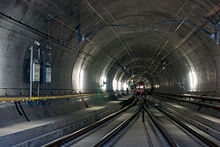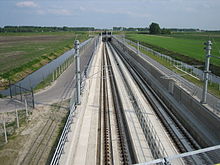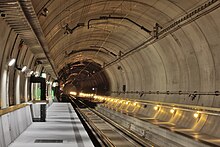
A railway track or railroad track, also known as a train track or permanent way, is the structure on a railway or railroad consisting of the rails, fasteners, railroad ties and ballast, plus the underlying subgrade. It enables trains to move by providing a dependable surface for their wheels to roll upon. Early tracks were constructed with wooden or cast iron rails, and wooden or stone sleepers; since the 1870s, rails have almost universally been made from steel.

The railway track or permanent way is the elements of railway lines: generally the pairs of rails typically laid on the sleepers or ties embedded in ballast, intended to carry the ordinary trains of a railway. It is described as a permanent way because, in the earlier days of railway construction, contractors often laid a temporary track to transport spoil and materials about the site; when this work was substantially completed, the temporary track was taken up and the permanent way installed.

A railroad tie, crosstie, railway tie or railway sleeper is a rectangular support for the rails in railroad tracks. Usually laid perpendicular to the rails, ties transfer loads to the track ballast and subgrade, hold the rails upright and keep them spaced to the correct gauge.

Maintenance of way refers to the maintenance, construction, and improvement of rail infrastructure, including tracks, ballast, grade, and lineside infrastructure such as signals and signs.

Track ballast is the material which forms the trackbed upon which railroad ties are laid. It is packed between, below, and around the ties. It is used to bear the compression load of the railroad ties, rails, and rolling stock; to facilitate drainage; and keep down vegetation that can compromise the integrity of the combined track structure. Ballast also physically holds the track in place as the trains roll over it. Not all types of railway tracks use ballast.
High-speed railway track construction is the process by which Lignes à Grandes Vitesses, the land on which TGV trains are to run, is prepared for their use, involving carving the track bed and laying the track. This construction technique is used both for the French TGV network and other TGV-based networks outside of France.
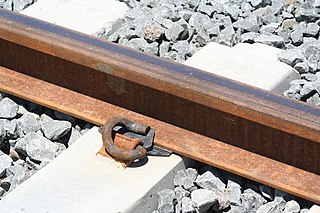
Pandrol is a global rail technology company, founded in 1953 and operating in over 100 countries worldwide, with over 400 railway systems having adopted its products.
Tramway track is used on tramways or light rail operations. As with standard rail tracks, tram tracks have two parallel steel rails, the distance between the heads of the rails being the track gauge. When there is no need for pedestrians or road vehicles to traverse the track, conventional flat-bottom rail is used. However, when such traffic exists, such as in urban streets, grooved rails are used.

A tamping machine or ballast tamper, informally simply a tamper, is a self-propelled, rail-mounted machine used to pack the track ballast under railway tracks to make the tracks and roadbed more durable and level. Prior to the introduction of mechanical tampers, this task was done by manual labour with the help of beaters. As well as being faster, more accurate, more efficient and less labour-intensive, tamping machines are essential for the use of concrete sleepers since they are too heavy to be lifted by hand.

A work train is one or more rail cars intended for internal non-revenue use by the railroad's operator. Work trains serve functions such as track maintenance, maintenance of way, revenue collection, system cleanup and waste removal, heavy duty hauling, and crew member transport.
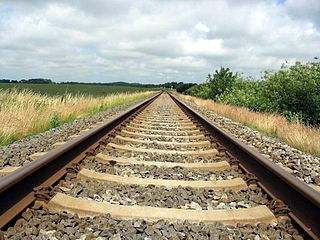
A concrete sleeper or concrete tie is a type of railway sleeper or railroad tie made out of steel reinforced concrete.

A deck is the surface of a bridge. A structural element of its superstructure, it may be constructed of concrete, steel, open grating, or wood. Sometimes the deck is covered by a railroad bed and track, asphalt concrete, or other form of pavement for ease of vehicle crossing. A concrete deck may be an integral part of the bridge structure or it may be supported with I-beams or steel girders.

A rail fastening system is a means of fixing rails to railroad ties or sleepers. The terms rail anchors, tie plates, chairs and track fasteners are used to refer to parts or all of a rail fastening system. The components of a rail fastening system may also be known collectively as other track material, or OTM for short. Various types of fastening have been used over the years.

Baulk road is the name given to a type of railway track or 'rail road' that is formed using rails carried on continuous timber bearings, as opposed to the more familiar 'cross-sleeper' track that uses closely spaced sleepers or ties to give intermittent support to stronger rails.
The Research Designs & Standards Organisation (RDSO) is the research and development and railway technical specification development organisation under the Ministry of Railways of the Government of India, which functions as a technical adviser and consultant to the Railway Board, the Zonal Railways, the Railway Production Units, RITES, RailTel and Ircon International in respect of design and standardization of railway equipment and problems related to railway construction, operations and maintenance.
Ladder track is a type of railway track in which the track is laid on longitudinal supports with transverse connectors holding the two rails at the correct gauge distance. Modern ladder track can be considered a development of baulk road, which supported rails on longitudinal wooden sleepers. Synonyms include longitudinal beam track.

A track renewal train is a work train that consists of many units of machinery and materials required for track renewal projects.

The Bözberg Rail Tunnel is a railway tunnel in the Swiss canton of Aargau. It takes the Bözberg railway line of the Swiss Federal Railways under the Bözberg Pass between Effingen and Schinznach-Dorf. The original tunnel was opened during 1875; it is set to be closed to rail traffic during 2020-2021 following the commissioning of its replacement, after which it shall be converted and retained for service and rescue purposes in respect to its successor.
The Glenbrook Tunnel is a double-track railway tunnel located on the Main Western Line, near Glenbrook, in the City of Blue Mountains local government area of New South Wales, Australia. The property is owned by the Transport Asset Holding Entity. The railway tunnel is part of the Glenbrook 1913 double-track deviation, which replaced the Glenbrook 1892 single-track deviation across the Blue Mountains. The tunnel is 283 metres (928 ft) long and was officially opened on 11 May 1913.

Green track is a type of railway track in which the track bed and surrounding area are planted with grass turf or other vegetation as ground cover. It is a popular way of making railways more visually appealing, particularly for trams and light rail, and providing additional urban green space. Aside from the visual improvement, the vegetation provides a number of positive effects, such as noise reduction, less air pollution, rainwater runoff mitigation, and reduced urban heat island effect.

